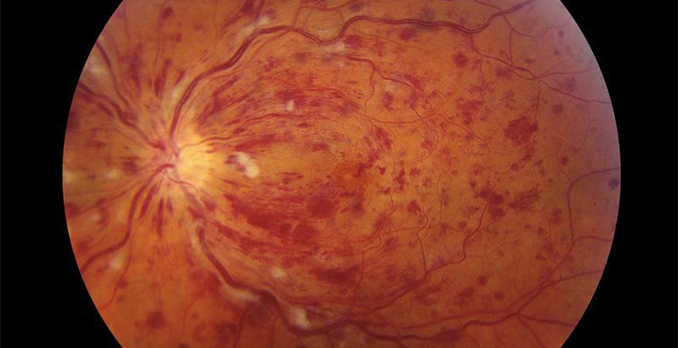
Differential Diagnoses:
Diabetic retinopathy
Ocular ischemic syndrome
Hyperviscosity retinopathy
Papilledema with hemorrhage
Diagnosis: Central retinal vein occlusion (CRVO)
Learnings: CRVO is a potentially blinding subacute vascular occlusion of the eye. The prevalence of CRVO is between 0.1% and 0.4% in individuals who are age 40 years or older. Most patients have associated local or systemic disease, with systemic hypertension, diabetes mellitus, and open-angle glaucoma being most common.
The central retinal artery and vein share a common adventitial sheath as they exit the optic nerve head and pass through the lamina cribrosa. Often in CRVO, a rigid atherosclerotic artery impinges on the nearby vein, causing turbulence and predisposing to thrombus formation. With increased resistance of venous flow, the retina becomes ischemic and fluid leaks out of the vessels. Increased intraocular pressure could also cause turbulence of the central retinal vein and lead to thrombus formation and obstruction.
The occluded central vein can lead to intraretinal hemorrhage, exudation of fluid, varying levels of ischemia, and neovascular complications such as neovascular glaucoma. CRVO is commonly classified by severity into 2 forms: the nonischemic form of CRVO, which is milder and more common, and the ischemic form, which results in more severe retinal damage and vision loss. In ischemic CRVO, more than 90% of patients have vision of 20/400 or worse. In one-third of patients with the nonischemic type, the disease progresses to the ischemic type.
Iris neovascularization, which is associated with neovascular glaucoma, occurs in up to 60% of patients with the ischemic form, usually 3 to 5 months after the obstruction. The main risk factors for development of neovascular glaucoma after a CRVO are the extent of capillary nonperfusion, poor visual acuity, severe venous tortuosity, and retinal hemorrhage.
The presenting visual acuity at the time of diagnosis of CRVO is the best predictor of visual prognosis. In a patient with CRVO, there is a 10% risk of developing a CRVO in the other eye, especially when there is an underlying systemic abnormality.
Acknowledgment: Image courtesy of Logical Images, Inc. (www.VisualDx.com/JUCM)
